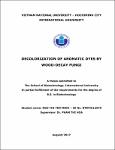| dc.description.abstract | The biodegradation of synthetic dyes by fungi is emerging as an effective and promising approach. Synthetic azo dyes are extensively used in textile industry and are not easily degraded into the environment due to their complex structure. This study was conducted to evaluate the degradation of aromatic dyes. In this study, the decolorization potential of white-rot fungi, toward decolorizing aromatic dyes, was investigated. The results of this study revealed that Pycnoporus coccineus, Pleurotus ostreatus, Flavodon flavus, Pycnoporus sanguine, Schizophyllum commune had the ability to efficiently degrade Congo red on solid media. However, malachite green inhibited the mycelial growth of Pycnoporus sanguine, Schizophyllum commune. Therefore, they did not decolorize malachite green on solid media. Pleurotus ostreatus, Flavodon flavus were able to effectively decolorize malachite green on solid media. Pycnoporus coccineus, Pycnoporus sanguine decolorized methylene blue more effectively than any of the other fungi evaluated in this study. In liquid culture, this study investigated the effect of glucose concentration and dye concentration in decolorization rates. As a result, with effects of dye concentrations, Pleurotus ostreatus had the highest decolorization rate with more than 85% of the Congo red, nearly 70% of the Malachite green, approximately 70% of the Methylene Blue. Flavodon Flavus decolorized a considerable amount of Malachite green especially more than 90% in concentration of dye 5mg/L. In the effects of glucose concentrations, Pleutorus ostreatus had the most effective with 3 types of dyes. The decolorization rate of Methylene blue is about 74%, decolorization of malachite green is approximately 83 %, in Congo red is about 75% in 7 days. Flavodon flavus had the most effective in Congo red with approximately 92% in decolorization rate. The rate of decolorization carried out at different dye concentrations revealed that the increase in dye concentration suppresses the percentage decolorization.
KEY WORDS: Aromatic dye, Decolorization, White-rot fungi, Concentration, Pycnoporus coccineus, Flavodon flavus, Pleurotus ostreatus | en_US |


